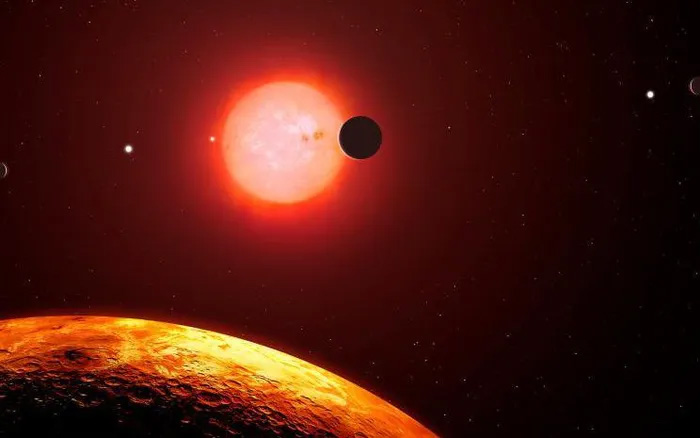A warning to the world from the newly found super-Earth
- Tram Ho
How close can a rocky planet (like Earth) be to a star (like the Sun) and still sustain water and life? When the Sun is getting bigger and bigger, what will be the fate of the Earth?
Isa Kaltenegger, Director of the Carl Sagan Institute (USA) and Associate Professor of Astronomy at the University of Arts and Sciences (USA), an exoplanet – super-Earth has been discovered near this could be the key to solving that mystery, providing important insights into conditions at the edge of a star’s “habitable zone,” or Goldilock zone. ; as well as answering the question of why Earth and Venus developed so differently.
That super-Earth is called LP 890-9c .
Not long ago, astronomers discovered LP 890-9c after observations by NASA’s space telescope.
LP 890-9c orbits its host star LP 890-9 (also known as TOI-4306 or SPECULOOS-2). LP 890-9 is a red dwarf star, located about 104 light-years from Earth, in the constellation Eridanus (Ba Giang).

Solar System LP 890-9 is about 104 light-years away. Photo: Internet
The host star LP 890-9 has a mass of only 0.16 solar masses, a radius of 0.12 solar radii, and a temperature of 2,850 K (2,577 degrees Celsius).
According to the study, red dwarfs are cooler than our G-type Sun, so when exoplanet LP 890-9c orbits just 6.4 million kilometers from its Sun, scientists think the exoplanet This planet may contain liquid water.
LP 890-9, which is orbited by at least two planets, is the second coldest star found to contain planets, after the TRAPPIST-1 system, scientists say.

LP 890-9 and its two planets are providing important insights into conditions at the inner edge of a star’s habitable zone. Photo: Adeline Deward, RISE-Illustration.
The inner planet, LP 890-9b, is about 30% larger than Earth and completes an orbit around its host star in just 2.73 days.
The outer planet, LP 890-9c, is similar in size to the first planet (about 37% larger than Earth) but has a longer orbital period of about 8.5 days.
Expert Lisa Kaltenegger’s team found that the “super-Earth” LP 890-9c orbits the inner edge of the LP 890-9’s habitable zone. LP 890-9c, receives 91% of that of Earth’s solar radiation, making it both a conservation and a habitable zone. This makes super-Earth LP 890-9c key to understanding how Venus and Earth have evolved.”
Super-Earth contains a “prophecy” for the Earth
Astronomers are hoping to observe LP 890-9c with the James Webb Telescope to see if they can predict Earth’s future as the Sun expands.
Dr Kaltenegger said: “Observing this planet will tell us what’s happening at the inner edge of the habitable zone – how long a rocky planet can remain habitable once it begins to warm from It will teach us something basic about how rocky planets evolve under increasing sources of sunlight (as the Sun expands in its cycle) and “prophecy” about what will happen to the Earth one day.”

Image simulating the evolution of exoplanet LP 890-9c from hot Earth to arid Venus. Source: Carl Sagan Institute/R. Payne
To explore the range of possible atmospheres and to assess whether transmission spectroscopy could shed light on that difference, astronomers created seven models for LP890-9c.
The team’s models are the first to detail differences in chemical signatures produced by rocky planets near the inner boundary of the habitable zone, based on variables including size size, mass, chemical composition, surface temperature and pressure, atmospheric altitude, and cloud cover.
Calculations are key to estimating how much time NASA/ESA/CSA’s James Webb Space Telescope will need to confirm the basic composition of the atmosphere – if at all.
According to astronomers’ forecasts, Earth is expected to experience scorching heat as the Sun gets brighter and hotter over time, causing the oceans to gradually evaporate and fill the atmosphere. with steam before evaporating completely.
How long that process may take is unknown, and astronomers say LP 890-9c offers a rare opportunity to explore that evolutionary process.
Previously, Belgian scientists have shown that, if the Sun expands 100 times, the planets near it such as Mercury, Venus, and Earth will be “swallowed” in the terrible heat and life will completely perish.
Dr. Kaltenegger said: “This exoplanet (super-Earth LP 890-9c) is the first target where we can test these different scenarios. liquid and the conditions suitable for life, the destruction will be slower. But if that process happens quickly, all the water in the ocean will boil and evaporate completely, life will die along with it.” .
The team of scientists said it is possible that LP 890-9c has no atmosphere and no life, or it resembles Venus with thick clouds that block reflected light. Therefore, they need time to further study from the observations of the JWST and James Webb space telescope systems.
Source : Genk
